My 8 year old niece received QO and stays in hotel again. Mother has to serve another week of QO with her again. Yes. Another QO. The last QO was on 27 July to 5 Aug. Less than two weeks another QO. Reason of QO? Close contact with classmates. Why not just allow home base learning? The bus clusters are spreading fast and ferious, why not WFH by default?
-
IP addresses are NOT logged in this forum so there's no point asking. Please note that this forum is full of homophobes, racists, lunatics, schizophrenics & absolute nut jobs with a smattering of geniuses, Chinese chauvinists, Moderate Muslims and last but not least a couple of "know-it-alls" constantly sprouting their dubious wisdom. If you believe that content generated by unsavory characters might cause you offense PLEASE LEAVE NOW! Sammyboy Admin and Staff are not responsible for your hurt feelings should you choose to read any of the content here. The OTHER forum is HERE so please stop asking.
You are using an out of date browser. It may not display this or other websites correctly.
You should upgrade or use an alternative browser.
You should upgrade or use an alternative browser.
Covid-19 pandemic - mismanagement by PAP government
- Thread starter LITTLEREDDOT
- Start date
Quote: "The reply from the authorities was that if vaccination status checks were required at hawker centres and coffee shops, they would add to the burden of already struggling operators and stallholders."
The Safe Distancing Ambassadors can be tasked to check vaccination status.
AUG 31, 2021
Makansutra founder K.F. Seetoh has said that it is ironic that the cap on dining in at coffee shops and hawker centres remains at two, while it is set at five for air-conditioned foodcourts and restaurants (Impractical to raise dine-in caps at hawker centres: MOH, NEA, Aug 27).
Ironic indeed. Hawker centres and coffee shops are visited by moderate-income earners.
The cost of eating at a restaurant is easily four or five times what we would spend at hawker centres. We cannot afford that every day.
Why disallow my family of five, or five friends, to have an economical meal together at the same table when we have all been vaccinated?
The reply from the authorities was that if vaccination status checks were required at hawker centres and coffee shops, they would add to the burden of already struggling operators and stallholders.
They also said that dining in is a high-risk activity as masks are removed and people are interacting at close quarters, and that an unvaccinated diner who gets Covid-19 is at high risk of falling very ill.
Granted, the Government is doing stall owners a favour, but what about the majority of consumers, namely the close to 80 per cent who are fully vaccinated?
It does not make sense that the dine-in curbs seem to penalise those who heeded the call to be vaccinated, to protect those who are unvaccinated.
Daniel Chan Wai Piew
The Safe Distancing Ambassadors can be tasked to check vaccination status.
Forum: Allow groups of vaccinated people to eat at hawker centres as it's a cheaper dining option
AUG 31, 2021
Makansutra founder K.F. Seetoh has said that it is ironic that the cap on dining in at coffee shops and hawker centres remains at two, while it is set at five for air-conditioned foodcourts and restaurants (Impractical to raise dine-in caps at hawker centres: MOH, NEA, Aug 27).
Ironic indeed. Hawker centres and coffee shops are visited by moderate-income earners.
The cost of eating at a restaurant is easily four or five times what we would spend at hawker centres. We cannot afford that every day.
Why disallow my family of five, or five friends, to have an economical meal together at the same table when we have all been vaccinated?
The reply from the authorities was that if vaccination status checks were required at hawker centres and coffee shops, they would add to the burden of already struggling operators and stallholders.
They also said that dining in is a high-risk activity as masks are removed and people are interacting at close quarters, and that an unvaccinated diner who gets Covid-19 is at high risk of falling very ill.
Granted, the Government is doing stall owners a favour, but what about the majority of consumers, namely the close to 80 per cent who are fully vaccinated?
It does not make sense that the dine-in curbs seem to penalise those who heeded the call to be vaccinated, to protect those who are unvaccinated.
Daniel Chan Wai Piew
We're getting worried because the number spikes. As mentioned from my previous posts, we, the vulnerable employees, are concerned and we are helpless when employers push us back to the offices. The much healthier, however, remains WFH. Daily, we can only pray for our safety. We thought that we can turn to MOM for help but MOM, instead, said that the employers know the best. The unemployment rate rises and a survey identified us that we are the most fatigued people in the world. Please be more considerate and help the vulnerable employeesus Vulnerable and most helpless. Today, I saw a colleague sneezed like nobody business and I found that mucous were everywhere on the walls inside the toilet. Won't the virus spread?
MOH said it has uncovered several large clusters and expects the number to escalate to 1,000 to 2,000. Reason for the spike? Higher levels of interaction in social gatherings and workplaces. Action plans? Intensify testings. C'mon, testings are passive strategies. Instead of implementing WFH after one employee has been tested positive, why not immediately start WFH by default? MOM has given the rights to the employers to do what they deemed fit. My immediate supervisor pushed me to the front even doctor certified that I have chronic disease. Should I wait for a colleague or myself to be the one tested positive then my employer will allow WFH?
Touching vegetables gives chance to transmit the virus. How about touching papers, equipments and stationeries in the offices? For years, employers have worked hard to achieve paperless offices. Money spent. Still, these employers still feel safer to touch hardcopies.
Tighter measures at bus interchanges needed after Covid-19 clusters

There were at least 314 Covid-19 cases at eight bus interchanges as at Wednesday night.
ST PHOTO: TIMOTHY DAVID
Isabelle Liew and Clement Yong
SEP 3, 2021
SINGAPORE - The growing Covid-19 clusters at bus interchanges suggest that workplace practices across different interchanges could be causing the virus to spread, said an infectious disease expert.
This warrants closer investigation, said Dr Leong Hoe Nam from the Rophi Clinic, as he called for measures at these places to be tightened.
There were 314 Covid-19 cases at eight bus interchanges as at Wednesday (Sept 1).
"It could be the rest areas, the way they hand over and talk. There might also be a need to look at toilets, where they take out their masks, wash their faces - the toilet may turn out to be the most contaminated place," he said.
"The really essential workers, who cannot afford to fall sick, should wear proper surgical masks instead of cloth masks. I still see some people using last year's National Day Parade masks - those are not good."
There are about 9,500 bus drivers here, and the Land Transport Authority (LTA) has said that 99 per cent of front-line public transport workers have completed their first dose of a vaccine.
More than 95 per cent are fully inoculated, and in the light of recent developments, workers have been told to take their meals and smoke breaks alone, regardless of their vaccination status.
Assistant Professor Terence Fan at the Singapore Management University's Lee Kong Chian School of Business, who specialises in transport issues, said another way to minimise risks is to set up plexiglass panels around the bus driver's seat.
The National Transport Workers' Union trialled this measure in the wake of assaults on bus drivers last year. It has not been widely adopted, in part due to continuing concerns that the reflection caused by these panels affected the vision of drivers.
Prof Fan also suggested increasing the frequency of rostered testing for bus drivers until the current wave subsides. Right now, the frequency of testing differs by bus operator.
Most commuters interviewed said they were not overly worried about the growing clusters.
Mr Tan Chong Tee, 71, said he usually tries to avoid places where there are Covid-19 clusters, but has to take a bus home from Jurong East Bus Interchange five days a week.
The interchange had a total of 28 Covid-19 cases linked to staff members there as at Wednesday.
"There's only so much I can do, I wear a mask and follow the regulations, so if I get it, it can't be helped," said the fully vaccinated factory worker.

Undergraduate Nirmal Kishore, 23, who frequents Tampines Bus Interchange - where there is another cluster with a total of 23 Covid-19 cases - said he tries not to touch surfaces in buses in case they may be contaminated.
"I try to make sure I come into contact only with the bus seat and I'll try not to touch the handles. But I have hand sanitiser with me at all times so it's not much of a concern," he said, adding that he is fully vaccinated.
Ms Xue Lianli, 49, a part-time cleaner who works near Jurong East Bus Interchange, said she avoids touching her face while in public areas. "I sanitise after I get off the bus. I still have to come here for work, so I just make sure to wear my mask properly everywhere," she said.
Covid-19: Bus interchanges clusters could be super-spreader events, says expert | THE BIG STORY
Prof Fan said it is not clear at this point if all the bus drivers were infected by the same strain, and that the situation will be clearer after virologists' analyses.
For those who live together and are close contacts of one another, however, the risk of mutual infection is increased. Even without such factors, the risk of exposure for bus drivers is already "inherently high" as they come into contact with hundreds of commuters every day.
He added, however, that the practice of interlining - where bus drivers ply different routes, sometimes in the same shift - might not be as dangerous as it sounds, as the number of commuters the driver is exposed to remains roughly the same.
"It does not hurt to encourage more instances of working from home in the meantime," Prof Fan noted.
"This can help reduce the number of commuters on buses and slow down any continuing spread."
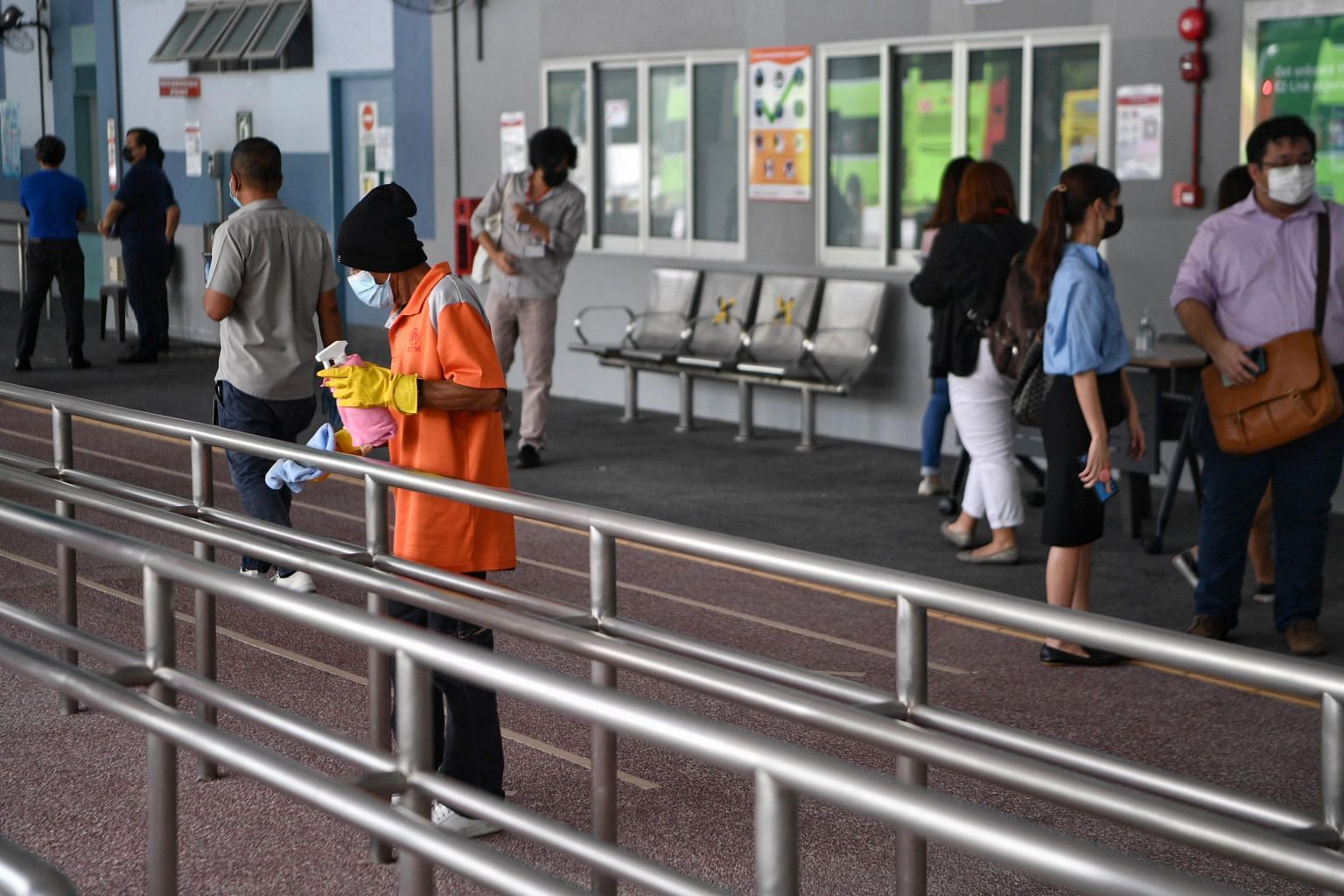
Dr Leong said vaccinated commuters need not panic and can take additional precautions such as wearing two masks, or ones that loop around the back of their heads.
"It's simple physics - the tighter the mask to the cheek, the more you breathe in filtered air," he said.
"Bus interchange clusters are highlighted because of contact tracing, but the same scenario may happen to, say, a popular nasi lemak store with many people queueing.
"Some people might ask why (bus interchange clusters did not occur) earlier, but the opportunity had not arisen, the virus was maybe not as transmissible."
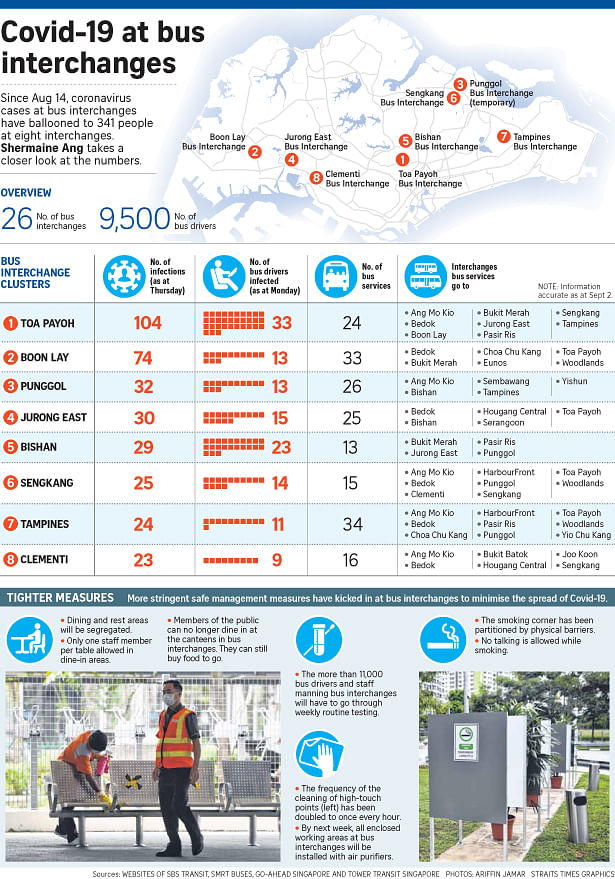
Commuters may see longer waits for buses if Covid-19 clusters at bus interchanges worsen

Contingency plans are in place to lengthen the intervals between bus services if more bus drivers are affected.ST PHOTO: CHONG JUN LIANG

0Clement Yong
SEP 2, 2021
SINGAPORE - Commuters may have to wait longer for buses if Covid-19 clusters at public bus interchanges continue to grow, though the Land Transport Authority (LTA) said there is no major impact on bus operations for now.
At a briefing on Thursday (Sept 2) on the clusters, the authority said contingency plans are in place to lengthen the intervals between bus services - starting with routes with the lowest demand - if more bus drivers are affected.
These plans were worked out with the public transport operators before the pandemic, for cases of severe manpower disruption.
As at Wednesday, 284 front-line staff at bus interchanges have tested positive for Covid-19. Another 200 or so staff are in quarantine.
These together amount to less than 5 per cent of the 11,000 front-line staff in the bus sector, the LTA noted.
"Any lengthening of bus service headways required will be progressive, starting with low-demand bus services to minimise the impact on commuters," the LTA said.
The Straits Times understands that at least one service is already running at longer intervals.
Bus controllers will adjust the bus schedules as needed, which could lead to commuters waiting five to 10 minutes longer.
LTA chief executive Ng Lang said the more stringent measures announced on Thursday prioritise the safety of bus drivers.
"What has changed in this situation now is that fact that we have more Covid-19 cases and the variant is a lot more transmissible. The workers are very much like us, they are members of the community, and they are exposed to the same risks," he said.
Some of the foreign bus drivers stay together in rented flats, and ST understands that there are no plans as of now to make adjustments to where and how workers live.
Such living arrangements are also in place in other industries. For instance, some foreign nurses and hawkers from other countries also stay in rented flats.

More than 5k Tokyo bars rebel against Covid-19 rules. They have deliberatelyflouting the rules and demanding for better strategy to tackle the virus. Besides Japan, many other countries are also demanding for better strategies from their governments. People, here, are still remaining calm and cooperating with the authorities. Easier jobs when compared with other countries. Hope that we can do a better job. Nonetheless, there are few things that need to consider again. Things include reports of unlinked cases and shortening of quarantine period. Not reporting unlinked cases and shortening the quarantine period may send a false signal that we are controlling the virus well. Which in fact, no. Possible result, more people will off guard after 10 days since the quarantine order is served.
Total number of normal ward admission @ 12 Sept: 719. Highest percentage is 28% and this group consists of people from age70 and abov, second highest 21% consists of people age 40 to 60. Follow by two different age groups 61 to 70 and below 11. 125 children aged 11 and below have admitted to hospitals because of Covid-19. And, they are not vaccinated. Most of them stay with parents who might be working from offices? ??
Lucky or unlucky? I have 4 relatives staying at different addresses, are tested positive for COVID-19 on Sunday. All went homes to wait for pick up to hospitals. No sound and no picture. All still staying at homes. Should not they be immediately send to hospitals? Third day now and still at homes with no QO devices tagged on them yet. How can reduce transmission in the community?
Covid-19 infections linked to S'pore bus interchange clusters rise to 504, with 30 new cases

The cluster at Toa Payoh bus interchange has 161 cases after nine new cases were added on Sept 6, 2021.
ST PHOTO: KUA CHEE SIONG
Isabelle Liew
SEP 7, 2021
SINGAPORE - The number of Covid-19 cases linked to staff at eight bus interchanges now stands at 504, with 30 new cases reported on Monday (Sept 6).
The cluster at Toa Payoh bus interchange has 161 cases, after nine new cases were added, the Ministry of Health (MOH) said in its daily update on Monday night.
Twelve new cases were also added to the cluster at Boon Lay bus interchange, taking its total to 126.
The clusters at the Tampines, Clementi, Sengkang and Jurong East interchanges each grew by between one and four cases.
No new cases were added to the Bishan and Punggol interchanges.
Meanwhile, the Bugis Junction cluster had five new cases, with a current total of 283.
The North Coast Lodge cluster grew to 196 cases, with 16 new cases added, while five cases were linked to the Changi General Hospital cluster, which now stands at 51 cases.
MOH added that four clusters have been closed. With no new clusters, there are currently 53 active clusters of infection.
Singapore reported a total of 241 new Covid-19 cases on Monday, including 235 locally transmitted cases and six imported ones. There were 110 unlinked locally transmitted cases.
Six of the locally transmitted cases were seniors above 70 who are unvaccinated or partially vaccinated, and at risk of serious illness.
There are 637 Covid-19 patients still in hospital.
These include six in critical condition in the intensive care unit, and 21 who require oxygen support.
Overall, the number of new cases in the community has increased from 723 cases the week before to 1,325 cases in the past week.
The number of unlinked cases in the community over one week has also increased from 146 cases to 573 over the same period.
MOH also gave an update on vaccination in Singapore, noting that around 8.79 million doses of Covid-19 vaccines have been administered under the national vaccination programme.
As at Sunday, 81 per cent of the population have been fully vaccinated, while 83 per cent have received at least one dose, added the ministry.
Singapore has had 55 deaths from Covid-19 complications.
Daily Covid-19 cases likely to soon exceed 1,000, next 2-4 weeks crucial for Singapore

The average daily number of Covid-19 cases has risen from 76 two weeks ago to 288 in the past week.ST PHOTO: KELVIN CHNG

Linette Lai
Political Correspondent
SEP 10, 2021
SINGAPORE - The sharp rate of increase in local Covid-19 cases is worrying and the next two to four weeks will be crucial in terms of whether higher infection numbers will lead to more serious cases and deaths, said Trade and Industry Minister Gan Kim Yong on Friday (Sept 10).
The average daily number of Covid-19 cases has risen from 76 two weeks ago to 288 in the past week. The Health Ministry (MOH) expects this figure to exceed 1,000 soon, with more cases picked up through intensified testing.
Addressing reporters at a press conference, Mr Gan noted that many people have asked if the Government is going back on its plans to reopen the economy despite Singapore's high vaccination rates. About 81 per cent of the population has been fully vaccinated.
These concerns arose after Finance Minister Lawrence Wong on Monday urged Singaporeans to reduce non-essential social activities for the next two weeks as Covid-19 cases spiked.
"While we understand that many prefer a straighter road to Covid-19 resilience, we have said before that we must expect some twists and turns along the way," Mr Gan said. "Given the unpredictability of the virus, we need to be prepared to adjust our plans as we go along."
He added that Singapore will continue to push for higher vaccine coverage, even as it speeds up the roll-out of booster shots and steps up nationwide testing.
In response to the surge in cases, the country will change the way it tracks down and manages Covid-19 patients.
It will focus its contact tracing and quarantine efforts on large clusters and vulnerable settings such as hospitals, as growing infection numbers make it difficult for contact tracers to keep up with every case.
The quarantine period from 14 days to 10 days from next week, as the Delta variant – the most dominant strain in Singapore – has a shorter incubation period than the original “wild-type” virus.
Vaccinated patients will also be discharged as early as seven days into their illness – down from if they have very low or undetectable viral loads, meaning that they are no longer infectious.
And a pilot scheme for fully vaccinated patients to recover at home, which was set up on Aug 30 and originally intended to run a month, will be expanded from Sept 15.
During the press conference by the multi-ministry task force tackling the pandemic in Singapore, Health Minister Ong Ye Kung said the experience of other countries has demonstrated that transmission waves typically take four to eight weeks to peak before numbers start to decline, he said.
As Singapore is now 18 days - about 2½ weeks - into the current wave, it is likely to see cases increase exponentially, potentially hitting a peak of around 3,000 before it begins to stabilise. But how this actually unfolds will depend on what Singaporeans do collectively - including whether it tests extensively, Mr Ong said.
Covid-19 transmission waves take 4 to 8 weeks to peak
The higher numbers mean Singapore must be cautious, said Mr Wong, who co-chairs the task force with Mr Gan and Mr Ong.
While there is no need to return to stricter measures, it is also not prudent for the country to press ahead with further reopening measures, he added.
"During this period, especially when we are in the midst of an exponential rise in infection cases, that would be a reckless thing to do."
He acknowledged that some segments of the population were disappointed at being told to cut back on social activities, but added that others had expressed concern over the rising number of cases and called on the Government to further tighten restrictions.
“We hear all these views, we are monitoring the situation very carefully and we will continue to consult our experts on the best way forward,” he said.
S’pore’s daily Covid-19 cases likely to soon exceed 1,000, cautious approach needed: Lawrence Wong
On Friday, Singapore's director of medical services Kenneth Mak also gave details of how vaccination can help protect against the worst effects of Covid-19.
For instance, a study by the National Centre for Infectious Diseases showed that vaccinated individuals saw their risk of infection reduced by nearly two times.
And while 0.1 per cent of vaccinated individuals typically need intensive care, that risk is 10 times higher for the non-vaccinated, Associate Professor Mak said.
People need to act to avoid Covid-19 cases rising to 3,200 cases daily: Ong Ye Kung
What seniors and other vulnerable groups can do to protect themselves from Covid-19
In Britain, a spike in cases following the removal of restrictions did not translate into increased numbers of people requiring oxygen support or intensive care, he added."We hope that our local experience will be similar," Prof Mak said. "Nonetheless, it will be prudent for us to exercise caution. Now is not the time to celebrate our own version of a Freedom Day - and particularly if you're vulnerable to severe infections or bad outcomes."
Read next - Shorter quarantine, more Covid-19 patients can recover at home: New measures at a glance
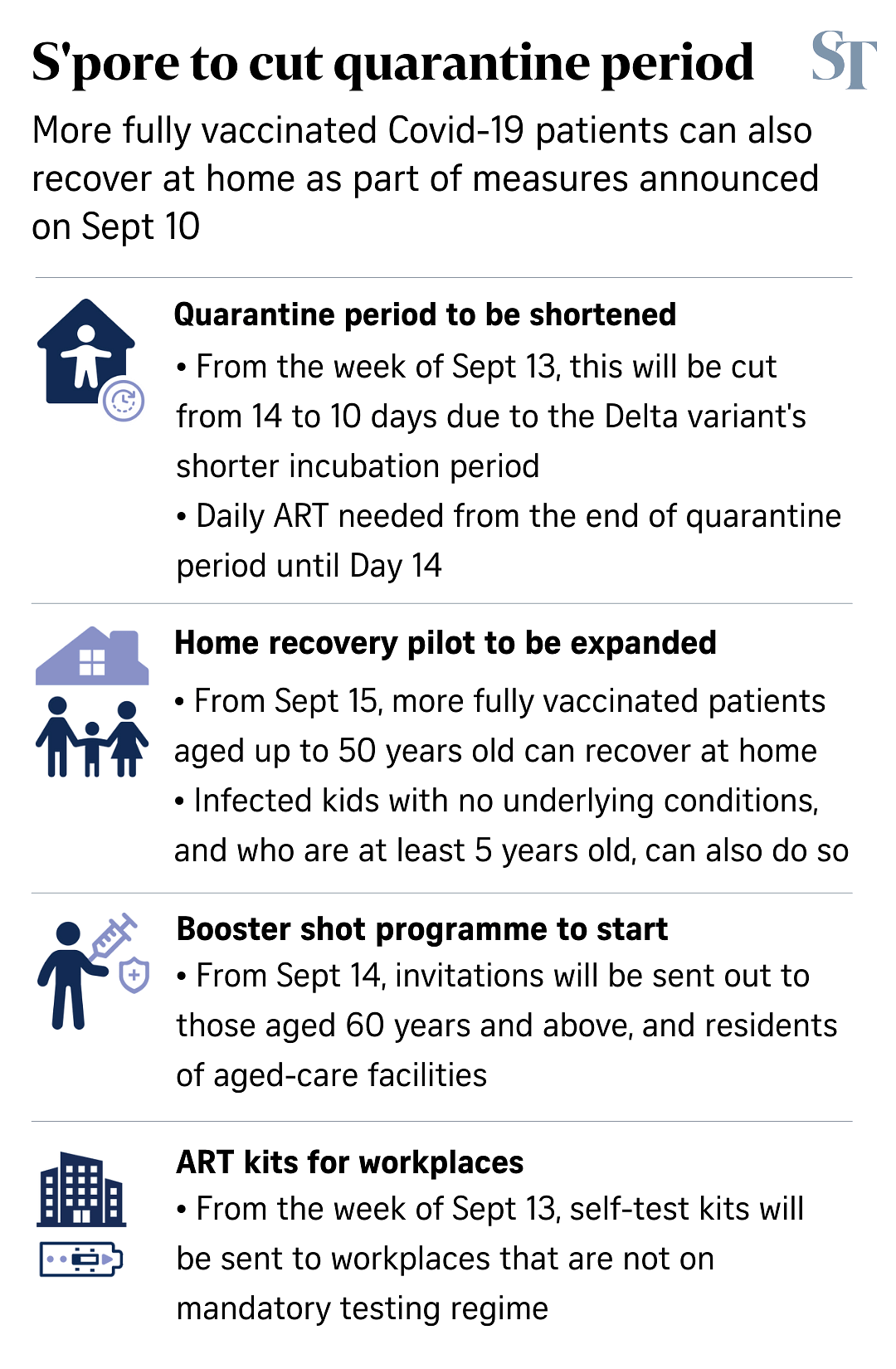
It has been suspected that the virus was transmitted from the toilet in Chinatown. The wife said that his husband always had his meals at his own stall at his first floor. Rarely he went to Chinatown Complex second level except buying food. Alas, I am sad and worried that my office toilet might transmit the virus too. Why are we still wio when we can wfh?
Covid-19 self-test kits given to primary school pupils with mixed instructions, say parents

Seven-year-old Kaleb Ng took the test on Sept 13 with help from his parents and tested negative.PHOTOS: COURTESY OF LEONARD NG

Goh Yan Han
SEP 13, 2021
SINGAPORE - Distribution of antigen rapid test (ART) kits to all primary school pupils began on Monday (Sept 13) as the children returned to school after their September holidays.
Each pupil is set to receive three test kits.
However, the instructions that were given to pupils from different schools collecting the test kits varied, according to parents The Straits Times spoke to.
Some were told to take one test on Monday and report the result on Tuesday, while others were told to take one and report the result by the end of the week. Others were not told to report results but to take one test in order to get familiar with the procedure.
In a Facebook post on Sunday, Education Minister Chan Chun Sing had announced the distribution of the test kits to all primary school pupils as part of a four-pronged approach to keep schools safe from Covid-19.
The approach also includes keeping children at home if they are unwell, safe management measures in schools, and ring-fencing known Covid-19 cases and contacts.
In his post, Mr Chan encouraged all families to help pupils do a self-test at home this week, which would “serve as a one-time sweep to assure one another that our children are safe”.
In a letter to parents on Monday, the Ministry of Education (MOE) said the test kits will allow for a quick test of the pupils when there is possible exposure or suspicion of possible Covid-19 infection.
It also said that the schools would be engaging parents to help them learn how to conduct an ART swab for their child at home, and that the remaining test kits should be kept in a clean and safe place for future use.
Mr Leonard Ng, who has two sons, aged seven and nine, at St Gabriel’s Primary School, said his children were told to take a test and report the result to their form teachers by the end of the week.
They were given instructions on how to use the kits, and the younger son’s teacher taught them how to use it in class, said Mr Ng, 39, a counsellor at a social service agency.
“But my younger son, Kaleb, said he completely forgot how to use it already,” added Mr Ng.
Kaleb took the test after dinner on Monday with his parents’ help and tested negative.
He said that it was “uncomfortable, but not painful” and that it was “weird because it made his nose drippy after”.
Civil servant Ganesan Maniam, 52, said both his children - Jayashree, 12, and Kavi, 11 - received their kits from their teachers at Concord Primary School, who explained to them how to take the test. They have to report their test results to their form teacher by the end of the week. Both children tested negative on Monday night.
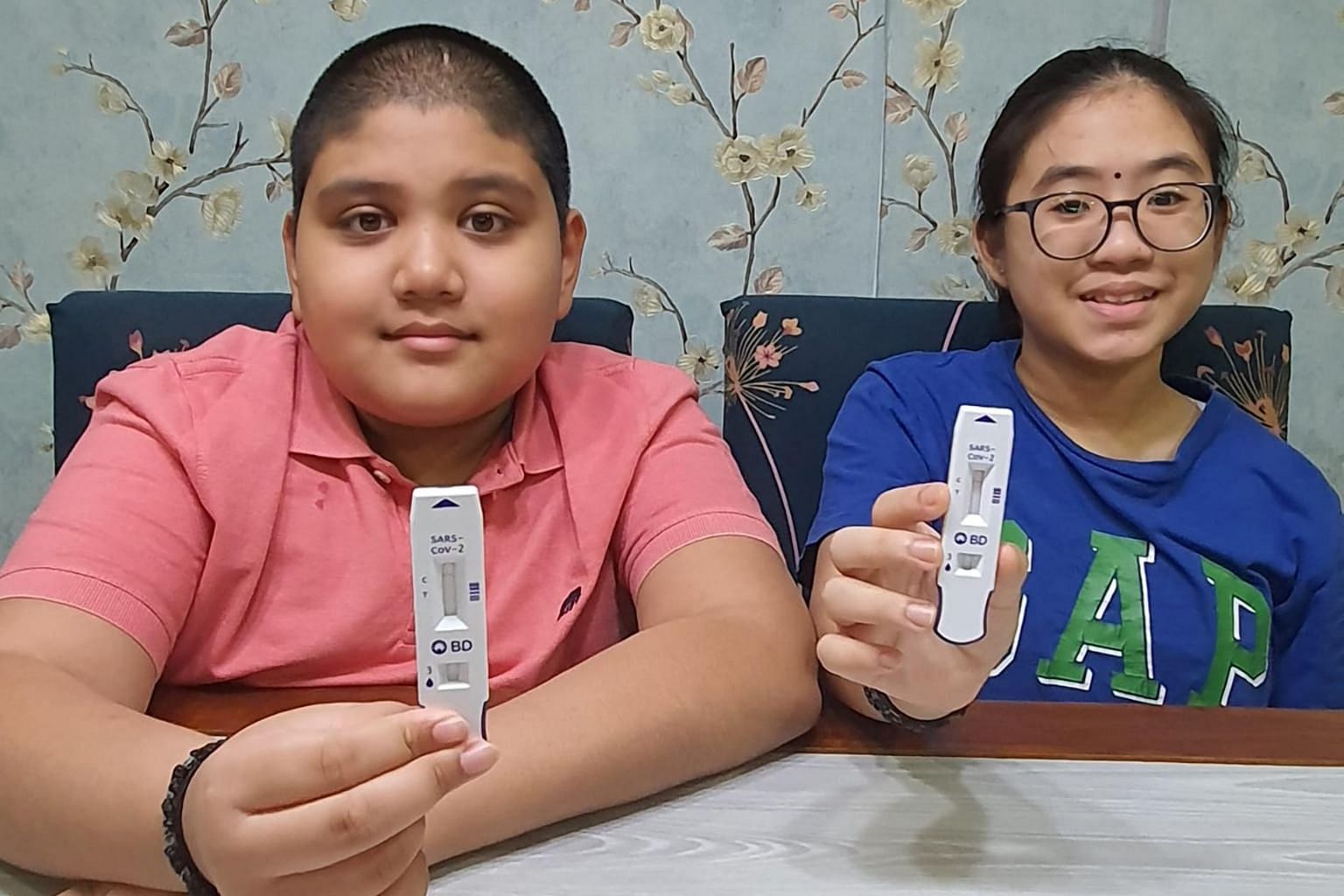
“There was a video shown to them. In Parents Gateway - an online portal for parents - there was also a slide and instructions,” he said.
He added that the test kits should have been given out to pupils before the schools closed for the holidays.
“This is to ensure that pupils take the test before coming to school, just in case they test positive upon their return today,” he said.
Ms Imelda Gani, 42, who has two sons, aged seven and nine, at Bukit Panjang Primary School, said her children were encouraged to try one kit with help from their parents. They received no instruction to report the results back to the teacher.
“This seems to be more about getting familiar with the process. I’ve never taken the ART myself, so helping them with it is a new experience,” said Ms Gani, an administrative executive.
“The instructions look easy to follow, thanks to the infographics, and some other parents from the school said they had done it today and that it’s very easy,” she added.
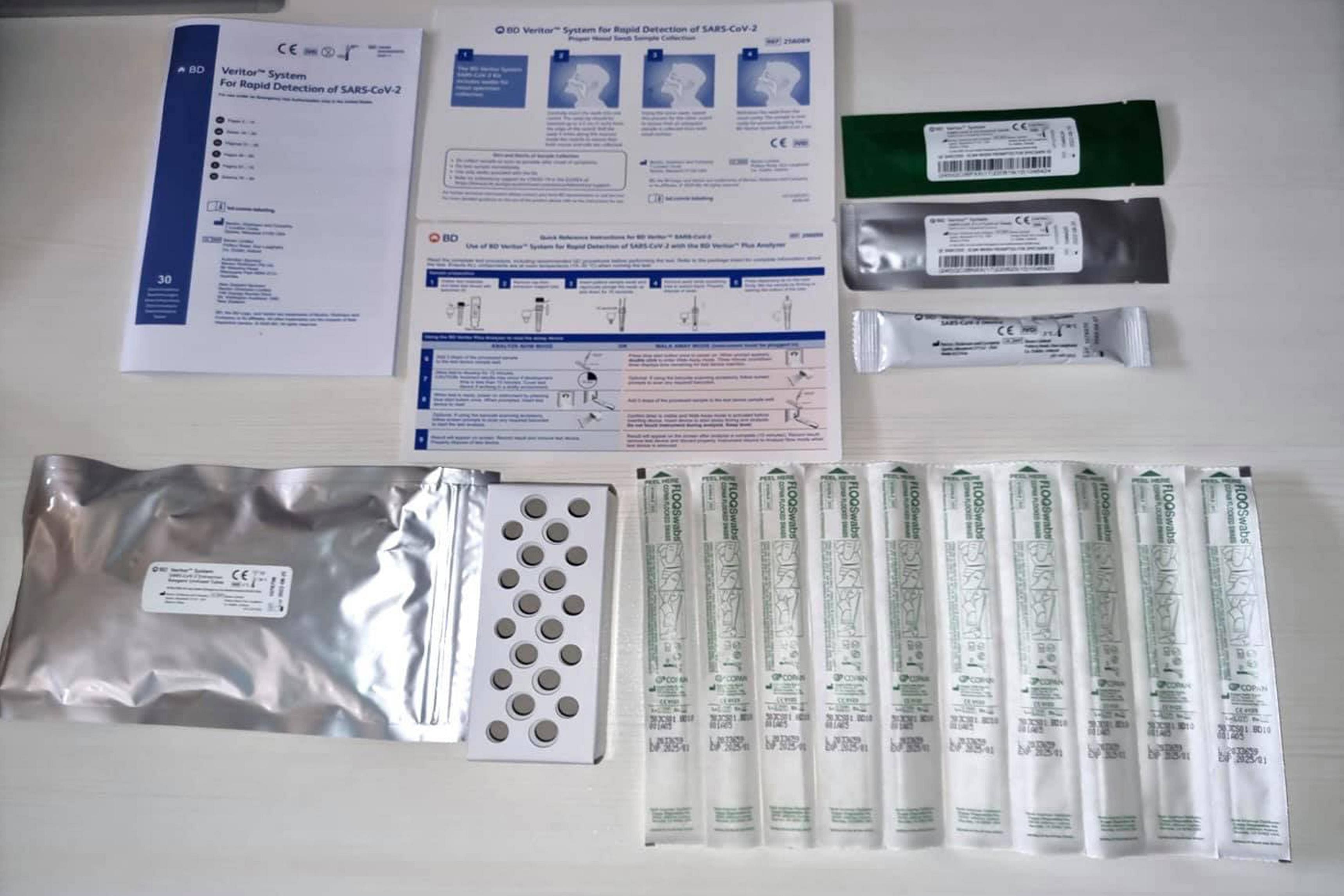
Ms Michelle Ang, who is in her 40s, said her 12-year-old daughter, a Primary 6 pupil at CHIJ Katong Convent, was encouraged to take one test this week and photograph the result. But she was also told that showing the teacher the picture was optional.
“The distribution is all very organised, but I am just wondering about the wasted tests. Why waste a perfectly good test - it seems like the kids are taking it for the sake of taking it,” she said.
ST has contacted the Education Ministry for more information on the use of test kits this week.
Some children, such as Mr Mohd Shaifful’s 12-year-old son at Townsville Primary, have yet to receive the kits.
Mr Shaifful, 42, a technician, said he is worried about the rising number of Covid-19 cases, as there was a confirmed case last week in the school his son attends.
He suggested that children be asked to take one ART test every week.
Other parents also expressed concern about the cases, but did not want to switch back to home-based learning (HBL).
Mr Ng said: “As a parent, I’m concerned about my kids for sure, but going back to HBL means affecting upcoming exams and parents will not be able to focus on work again. It’s something most parents would hope didn't happen, as it also makes it harder for children to learn.”Parents said they are taking other precautions instead, such as limiting going out of the house unless necessary and continuing to stress the importance of personal hygiene such as regularly using sanitiser and washing hands.
Said Ms Ang: “If we meet fewer strangers and go to fewer places, that’s better. If my daughter comes into contact with someone infected and ends up being quarantined, then there goes her Primary School Leaving Examination.”
Paid millions of dollars but none of the 4G ministers thought thoroughly about the procedures before implementing.
With the increase in the scope and frequency of compulsory Covid-19 tests at workplaces, I expect many more asymptomatic cases to be uncovered.
Many businesses can therefore be expected to be subject to a snap 14-day work-from-home (WFH) regime for workers who can do so.
While large enterprises may find it easier to cope with this requirement, small businesses will find it a tremendous burden.
The Government can help in two ways.
Since the quarantine period has officially been shortened from 14 days to 10 days in view of the Delta variant's shorter incubation period, the snap 14-day WFH requirement should also be shortened to 10 days.
Currently, those identified as close contacts of a confirmed Covid-19 case and issued a health risk warning need to isolate themselves only until they receive a negative polymerase chain reaction (PCR) test result.
The snap 14-day WFH requirement, which applies to workers who are not close contacts of the staff member who tested positive, is therefore, strangely, more stringent than the requirements for those issued a health risk warning.
The Government should give businesses the option of administering PCR tests to staff put on a snap WFH arrangement.
If a worker tests negative, he should be allowed to return to work without having to wait for 14 (or the shortened 10) days.
These proposed measures would greatly mitigate the mass disruptions expected among small businesses.
I believe employers would be willing to bear the costs of the tests as the alternative of facing potential closure of business for 10 or 14 days would be far worse.
Cheng Shoong Tat
Forum: Help mitigate disruption from WFH order when workplace infections occur
SEP 13, 2021With the increase in the scope and frequency of compulsory Covid-19 tests at workplaces, I expect many more asymptomatic cases to be uncovered.
Many businesses can therefore be expected to be subject to a snap 14-day work-from-home (WFH) regime for workers who can do so.
While large enterprises may find it easier to cope with this requirement, small businesses will find it a tremendous burden.
The Government can help in two ways.
Since the quarantine period has officially been shortened from 14 days to 10 days in view of the Delta variant's shorter incubation period, the snap 14-day WFH requirement should also be shortened to 10 days.
Currently, those identified as close contacts of a confirmed Covid-19 case and issued a health risk warning need to isolate themselves only until they receive a negative polymerase chain reaction (PCR) test result.
The snap 14-day WFH requirement, which applies to workers who are not close contacts of the staff member who tested positive, is therefore, strangely, more stringent than the requirements for those issued a health risk warning.
The Government should give businesses the option of administering PCR tests to staff put on a snap WFH arrangement.
If a worker tests negative, he should be allowed to return to work without having to wait for 14 (or the shortened 10) days.
These proposed measures would greatly mitigate the mass disruptions expected among small businesses.
I believe employers would be willing to bear the costs of the tests as the alternative of facing potential closure of business for 10 or 14 days would be far worse.
Cheng Shoong Tat
This ordinary citizen is better than the "experts".
Quotes:
"The threat that has been hung over our heads, of our "healthcare system getting overwhelmed", is sounding hollow. Those in charge must by now, with all the gathered data, be able to put in place a new system to adapt to foreseeable epidemiological developments."
"And no more restrictions, please. Otherwise, as Associate Professor Alex Cook said: "It seems we are unwilling to make vaccination compulsory, but are willing to impose continued restrictions on those who got vaccinated to protect those who declined to be vaccinated.""
SEP 14, 2021
I am getting rather Covid-19-case-numbers-and-bar-charts weary. Let us accept the endemicity of Covid-19 in all its mutated variants.
I do not understand the logic in Professor Teo Yik Ying's statement that "contact tracing to identify people who have been exposed to the virus and isolate them as soon as possible is important" (Unlinked cases less relevant when S'pore treats Covid-19 as endemic, Sept 10).
What is the point of identifying these groups of infected people through testing a multitude for the viral antigen, and keeping them from infecting others? After all, it is evident from the so far hundreds, and soon possibly to be thousands, of people infected daily (including the vaccinated) that, sooner or later, many in the population will encounter the virus and some will be infected and generally be none the worse, anyway.
The threat that has been hung over our heads, of our "healthcare system getting overwhelmed", is sounding hollow. Those in charge must by now, with all the gathered data, be able to put in place a new system to adapt to foreseeable epidemiological developments. Why should we look to other countries for examples of likely consequences?
Instead of dithering, let us move forward. We need new guidelines on issues such as recognising people who have been infected to the point of needing hospitalisation, having dedicated sections in hospitals to handle them, and general public and general practitioner awareness of these facilities.
We also need rules on the when and where of specific masking. It is obvious from the clusters all these months that viral transmission is increased when people are unmasked, for example, at home, chatting at meal times, drink socialising, at smoking corners and mingling.
Perhaps a campaign to "mask down for mouthfuls (or sips), mask up in between" and "mask up when too close, mask down 2m apart"?
And no more restrictions, please. Otherwise, as Associate Professor Alex Cook said: "It seems we are unwilling to make vaccination compulsory, but are willing to impose continued restrictions on those who got vaccinated to protect those who declined to be vaccinated." (Choosing the best option when none is ideal, Sept 8).
Our task force leaders may have to face up to the fact that we will never get all, or even most, of the unvaccinated people voluntarily vaccinated.
Resentment may be mounting against the continued restrictions, which no longer seem reasonable.
Amy Loh Chee Seen
Quotes:
"The threat that has been hung over our heads, of our "healthcare system getting overwhelmed", is sounding hollow. Those in charge must by now, with all the gathered data, be able to put in place a new system to adapt to foreseeable epidemiological developments."
"And no more restrictions, please. Otherwise, as Associate Professor Alex Cook said: "It seems we are unwilling to make vaccination compulsory, but are willing to impose continued restrictions on those who got vaccinated to protect those who declined to be vaccinated.""
Forum: Have guidelines for moving forward and living with Covid-19
SEP 14, 2021
I am getting rather Covid-19-case-numbers-and-bar-charts weary. Let us accept the endemicity of Covid-19 in all its mutated variants.
I do not understand the logic in Professor Teo Yik Ying's statement that "contact tracing to identify people who have been exposed to the virus and isolate them as soon as possible is important" (Unlinked cases less relevant when S'pore treats Covid-19 as endemic, Sept 10).
What is the point of identifying these groups of infected people through testing a multitude for the viral antigen, and keeping them from infecting others? After all, it is evident from the so far hundreds, and soon possibly to be thousands, of people infected daily (including the vaccinated) that, sooner or later, many in the population will encounter the virus and some will be infected and generally be none the worse, anyway.
The threat that has been hung over our heads, of our "healthcare system getting overwhelmed", is sounding hollow. Those in charge must by now, with all the gathered data, be able to put in place a new system to adapt to foreseeable epidemiological developments. Why should we look to other countries for examples of likely consequences?
Instead of dithering, let us move forward. We need new guidelines on issues such as recognising people who have been infected to the point of needing hospitalisation, having dedicated sections in hospitals to handle them, and general public and general practitioner awareness of these facilities.
We also need rules on the when and where of specific masking. It is obvious from the clusters all these months that viral transmission is increased when people are unmasked, for example, at home, chatting at meal times, drink socialising, at smoking corners and mingling.
Perhaps a campaign to "mask down for mouthfuls (or sips), mask up in between" and "mask up when too close, mask down 2m apart"?
And no more restrictions, please. Otherwise, as Associate Professor Alex Cook said: "It seems we are unwilling to make vaccination compulsory, but are willing to impose continued restrictions on those who got vaccinated to protect those who declined to be vaccinated." (Choosing the best option when none is ideal, Sept 8).
Our task force leaders may have to face up to the fact that we will never get all, or even most, of the unvaccinated people voluntarily vaccinated.
Resentment may be mounting against the continued restrictions, which no longer seem reasonable.
Amy Loh Chee Seen
Looks like one 'rite of passage' is not enough.
SG needs to hit 2,000 to go through two 'rites of passge'

Every country that has decided to live with the virus will sooner or later have to undergo a "major wave of transmission", just as Singapore is doing now.ST PHOTO: LIM YAOHUI

Linette Lai
Political Correspondent
SEP 18, 2021
SINGAPORE - The majority of Covid-19 patients will now recover at home, rather than in hospitals or designated facilities, as Singapore braces itself for an exponential surge in cases over the coming weeks.
This wave of infections was not unexpected and should be seen as a "rite of passage" for any country hoping to live with the disease, said Health Minister Ong Ye Kung on Friday (Sep 17).
The difference is that other countries encountered such waves early in the pandemic, but Singapore is only doing so after more than 80 per cent of the population has been fully vaccinated.
This unique situation makes it critical to keep an eye on the number of people who have become severely ill, Mr Ong said.
"We are on a path of transition to a new normal of living with Covid-19," the minister told reporters during a virtual press conference. "It is a journey that is uncertain and full of twists and turns."
The co-chair of the multi-ministry taskforce handling Covid-19 highlighted three unknowns that loom large in the days ahead.
First, Singapore does not know how long daily case numbers will rise before dipping.
It is also unclear whether the country will run out of intensive care unit capacity, although it is prepared to triple the number of available beds to 300 at short notice.
Lastly, it does not know if hospitals will be overburdened in general, with healthcare staff unable to cope with increased workloads.
With daily case numbers doubling every week, the country is soon likely to see 1,000 new cases in a single day. This means even community care facilities - which currently take in milder cases so that hospitals are not overtaxed - will be full soon, Mr Ong said.
This is why the country will put most Covid-19 patients on home recovery, with the scheme expanded to include those up to 69 years old.
To make testing more convenient, with 100 vending machines have been rolled out at 56 locations for those with health risk warnings to collect self-test kits.
These warnings are sent to people who have been in close proximity to a Covid-19 case for an extended period, according to SafeEntry data, or are identified as one of the infected person's close contacts.
Singapore reported 910 cases on Thursday evening, 803 of which were detected in the community. Another 103 were found in migrant worker dormitories, while the remaining four were imported.
Friday also marked 26 days since the country began grappling with the current wave of infections. More than 8,000 cases have been detected since the wave started, although the vast majority - over 98 per cent - have had no or mild symptoms.
The average number of daily cases has also gone up, from 146 a fortnight ago to 682 cases in the past week.
There is no doubt that numerous deaths would have occurred if people had not gotten vaccinated in large numbers, Mr Ong said, adding that the healthcare system would likely have been overwhelmed by now.
At present, the number of serious cases is not increasing at the same rate as the overall case count. This suggests the healthcare system will be able to cope, said Singapore's director of medical services Kenneth Mak. But he also urged caution, given that it is still early days yet.
"We do need to look at the situation over the next two weeks to better understand whether that trend continues," he said.
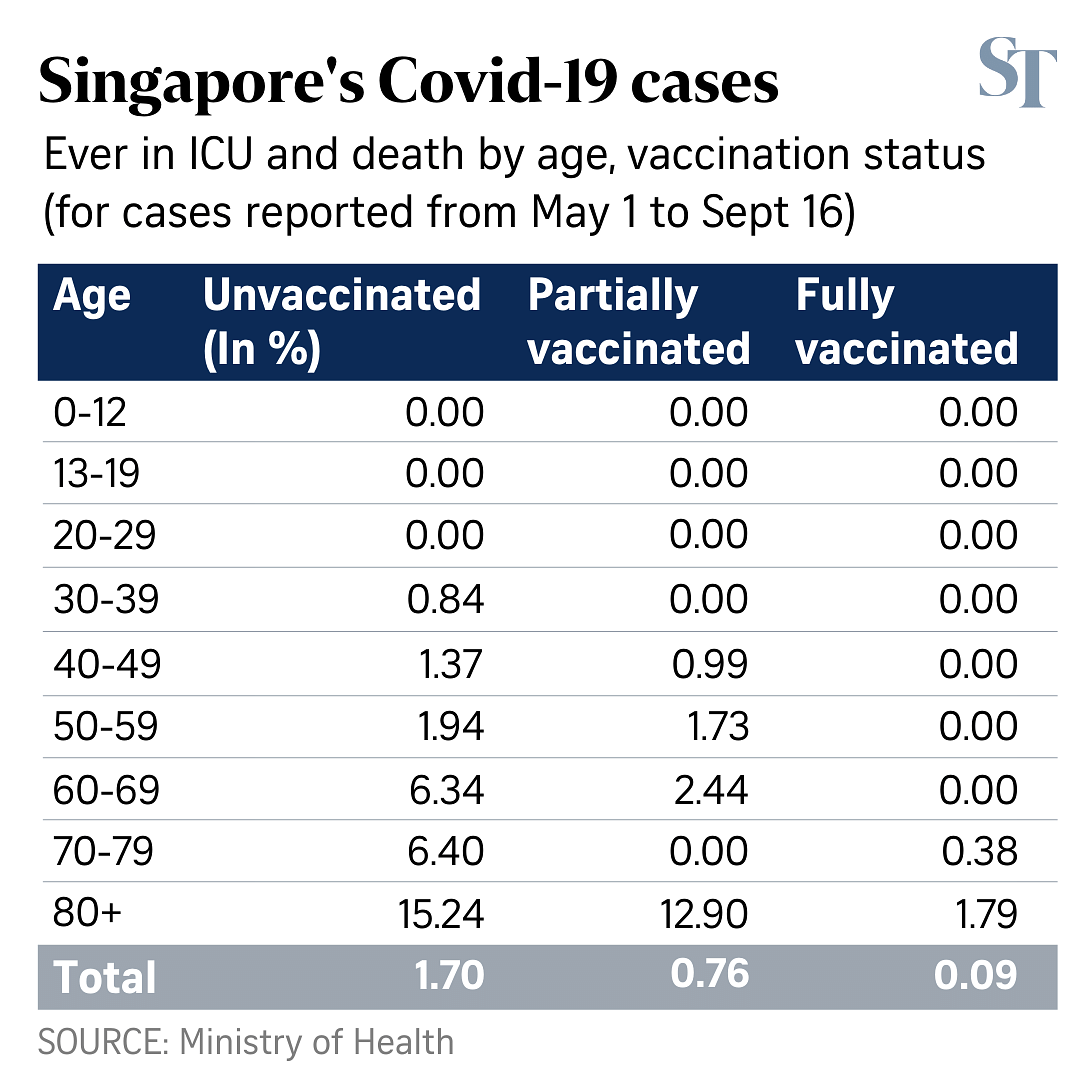
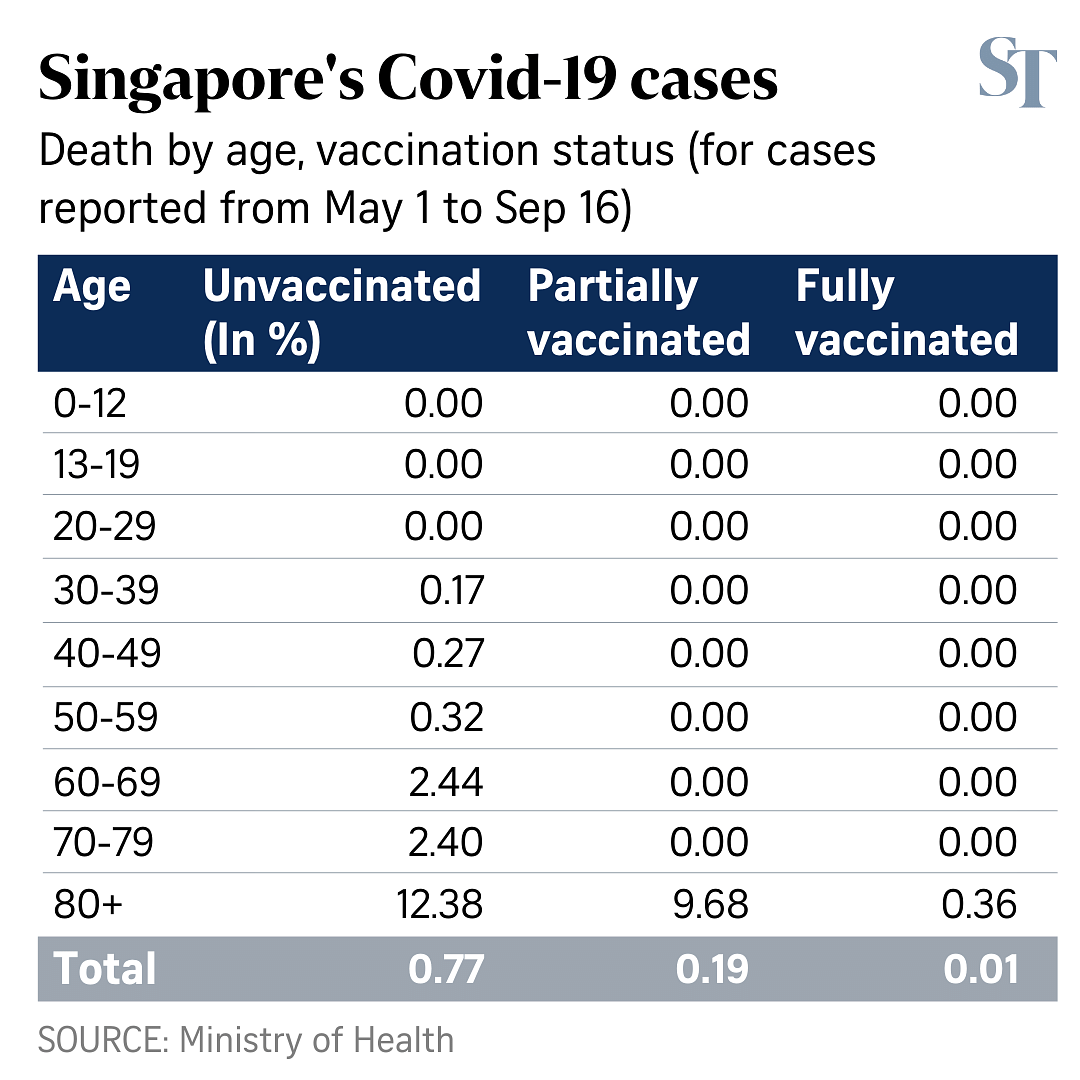
As the country navigates this next phase of its battle against Covid-19, Singaporeans should keep up their efforts at preventing the virus from spreading, including observing good personal hygiene and minimising social interactions.
"Even as our infections are still rising rapidly, we can all play our part to determine the trajectory of the infection curve," Mr Ong said.
"We are not the first country to have gone through this baptism of fire, and we will not be the last - but our position is different because we are more than 80 per cent vaccinated."

SG needs to hit 2,000 to go through two 'rites of passge'
S'pore's daily Covid-19 cases to hit 1,000 soon in 'rite of passage' before situation stabilises: Ong Ye Kung

Every country that has decided to live with the virus will sooner or later have to undergo a "major wave of transmission", just as Singapore is doing now.ST PHOTO: LIM YAOHUI

Linette Lai
Political Correspondent
SEP 18, 2021
SINGAPORE - The majority of Covid-19 patients will now recover at home, rather than in hospitals or designated facilities, as Singapore braces itself for an exponential surge in cases over the coming weeks.
This wave of infections was not unexpected and should be seen as a "rite of passage" for any country hoping to live with the disease, said Health Minister Ong Ye Kung on Friday (Sep 17).
The difference is that other countries encountered such waves early in the pandemic, but Singapore is only doing so after more than 80 per cent of the population has been fully vaccinated.
This unique situation makes it critical to keep an eye on the number of people who have become severely ill, Mr Ong said.
"We are on a path of transition to a new normal of living with Covid-19," the minister told reporters during a virtual press conference. "It is a journey that is uncertain and full of twists and turns."
The co-chair of the multi-ministry taskforce handling Covid-19 highlighted three unknowns that loom large in the days ahead.
First, Singapore does not know how long daily case numbers will rise before dipping.
It is also unclear whether the country will run out of intensive care unit capacity, although it is prepared to triple the number of available beds to 300 at short notice.
Lastly, it does not know if hospitals will be overburdened in general, with healthcare staff unable to cope with increased workloads.
With daily case numbers doubling every week, the country is soon likely to see 1,000 new cases in a single day. This means even community care facilities - which currently take in milder cases so that hospitals are not overtaxed - will be full soon, Mr Ong said.
This is why the country will put most Covid-19 patients on home recovery, with the scheme expanded to include those up to 69 years old.
To make testing more convenient, with 100 vending machines have been rolled out at 56 locations for those with health risk warnings to collect self-test kits.
These warnings are sent to people who have been in close proximity to a Covid-19 case for an extended period, according to SafeEntry data, or are identified as one of the infected person's close contacts.
Singapore reported 910 cases on Thursday evening, 803 of which were detected in the community. Another 103 were found in migrant worker dormitories, while the remaining four were imported.
Friday also marked 26 days since the country began grappling with the current wave of infections. More than 8,000 cases have been detected since the wave started, although the vast majority - over 98 per cent - have had no or mild symptoms.
The average number of daily cases has also gone up, from 146 a fortnight ago to 682 cases in the past week.
There is no doubt that numerous deaths would have occurred if people had not gotten vaccinated in large numbers, Mr Ong said, adding that the healthcare system would likely have been overwhelmed by now.
At present, the number of serious cases is not increasing at the same rate as the overall case count. This suggests the healthcare system will be able to cope, said Singapore's director of medical services Kenneth Mak. But he also urged caution, given that it is still early days yet.
"We do need to look at the situation over the next two weeks to better understand whether that trend continues," he said.


As the country navigates this next phase of its battle against Covid-19, Singaporeans should keep up their efforts at preventing the virus from spreading, including observing good personal hygiene and minimising social interactions.
"Even as our infections are still rising rapidly, we can all play our part to determine the trajectory of the infection curve," Mr Ong said.
"We are not the first country to have gone through this baptism of fire, and we will not be the last - but our position is different because we are more than 80 per cent vaccinated."

Similar threads
- Replies
- 7
- Views
- 451
- Replies
- 1
- Views
- 245
- Replies
- 1
- Views
- 462
- Replies
- 1
- Views
- 408
- Replies
- 1
- Views
- 358
